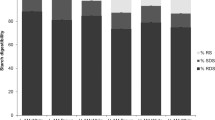Abstract
The effects of optimized slowly digestible starch (SDS) and resistant starch (RS) from rice starch on weight gain and lipid metabolism in mice (C57BL/6J mice) fed a high-fat diet were investigated. The optimum conditions for SDS were obtained at the pullulanse concentration (X 1) of 498 μL, storage temperature) (X 2) of 47°C, and A/C cycle (X 3) of 5, and for RS, were determined to be 838 μL (X 1), 62°C (X 2), and a cycle of 3 (X 3) using response surface methodology (RSM). Mice fed SDS and RS for 6 weeks showed both significantly decreased weight gain and fat pad weight (p<0.05). Significant decrease in total lipid, triglyceride, and cholesterol concentrations in serum and liver was observed in both SDS and RS group compared to HFD groups (p<0.05). Although both of intake SDS and RS significantly contributed to beneficial effects, RS groups was more effective than SDS group in all parameters.
Similar content being viewed by others
References
Mohan BH, Gopal A, Malleshi NG, Tharanathan RN. Characteristics of native and enzymatically hydrolyzed ragi (Eleusine coracana) and rice (Oryza sativa) starches. Carbohyd. Polym. 59: 43–50 (2005)
Skrabanja V, Liljeberg HGM, Hedley CL, Kreft I, Bjo¨rck IME. Influence of genotype and processing on the in vitro rate of starch hydrolysis and resistant starch formation in peas (Pisum sativum L.). J. Agr. Food Chem. 47: 2033–2039 (1999)
Englyst HN, Kingman SM, Cummings JH. Classification and measurement of nutritionally important starch fractions. Eur. J. Clin. Nutr. 46: S33–S50 (1992)
Bjorck I, Asp NG. Controlling the nutritional properties of starch in foods–a challenge to the food industry. Trends Food Sci. Tech. 5: 213–218 (1994)
Chung HJ, Liu Q, Hoover R. Impact of annealing and heat-moisture treatment on rapidly digestible, slowly digestible and resistant starch levels in native and gelatinized corn, pea and lentil starches. Carbohyd. Polym. 75: 436–447 (2009)
Moreau NM, Champ MM, Goupry SM, Bizec BJL, Kremp M, Nguyen PG, Dumon H J, Martin LJ. Resistant starch modulates in vivo colonic butyrate uptake and its oxidation in rats with dextran sulfate sodium-induced colitis. J. Nutr. 134: 493–500 (2004)
Frei M, Siddhuraju P, Becker K. Studies on the in vitro starch digestibility and the glycemic index of six different indigenous rice cultivars from the Philippines. Food Chem. 83: 395–402 (2003)
Annison G, Topping DL. Nutritional role of resistant starch: Chemical structure and physiological function. Annu. Rev. Nutr. 14: 297–320 (1994)
Gonzalez-Soto RA, Agama-Acevedo E, Solorza-Feria J, Rendon-Villalobos R, Bello-Perez LA. Resistant starch made from banana starch by autoclaving and debranching. Starch-Starke 56: 495–499 (2004)
Leong YH, Karim AA, Norziah MH. Effect of pullulanase debranching of sago (Metroxylon sagu) starch at subgelatinization temperature on the yield of resistant starch. Starch-Starke 59: 21–32 (2007)
Berry CS. Resistant starch: Formation and measurement of starch that survives exhaustive digestion with amylolytic enzymes during the determination of dietary fiber. J. Cereal Sci. 4: 301–314 (1986)
Folch J, Lees M, Stanley GHS. A simple method for the isolation and purification of total lipids from animal tissues. J. Biol. Chem. 226: 497–509 (1956)
Yuan H, Wang W, Chen D, Zhu X, Cao S. Characterization of resistant starch from Se-rich rice flour and its anti-diabetic effect in diabetic ICR mice. Starch-Starke 68: 106–111 (2016)
Koo SH, Lee KY, Lee HG. Effect of cross-linking on the physical and physiological properties of corn starch. Food Hydrocolloid. 24: 619–625 (2010)
de Deckere EAM, Kloots WJ, van Amelsvroot JM. Both raw and retrograded starch decrease serum triglycerol concentration and fat accretion in the rat. Brit. J. Nutr. 73: 287–298 (1995)
Kim WK, Chung MK, Kang NE, Kim MH, Park OJ. Effect of resistant starch from corn or rice on glucose control, colonic events, and blood lipid concentrations in streptozotocin-induced diabetic rats. J. Nutr. Biochem. 14: 166–172 (2003)
Jeong MK, Kim HH, Kang NE, Kim WK. Effects of resistant starch on gut functions and plasma lipid profiles in rats fed high fat diet. J. Korean Soc. Food Sci. Nutr. 31: 271–276 (2002)
Lee CJ, Shin SI, Kim Y, Choi HJ, Moon TH. Structural characteristics and glucose response in mice of potato starch modified by hydrothermal treatments. Carbohyd. Polym. 83: 1879–1886 (2011)
de Deckere EAM, Kloots WJ, van Amelsvoort JMM. Resistant starch decreases serum total cholesterol and triacylglycerol concentrations and fat accretion in the rat. Brit. J. Nutr. 73: 74–76 (1993)
de Deckere EAM, Kloots WJ, van Amelsvoort JMM. Both raw and retrograded starch decrease serum triacylglycerol concentration and fat accretion in the rat. Brit. J. Nutr. 72: 287–298 (1995)
Vanhoof K, de Schrijver R. The influence of enzyme resistant starch on cholesterol metabolism in rats fed on a conventional diet. Brit. J. Nutr. 80: 193–198 (1998)
Behall KM, Scholfield DJ, Yuhaniak I, Canary J. Diets containing high amylose versus amylopectin starch: Effects on metabolic variables in human subjects. Am. J. Clin. Nutr. 49: 337–344 (1989)
Choi WH, Gwon SY, Ahn J, Jung CH, Ha TY. Cooked rice prevents hyperlipidemia I hamsters fed a high-fat/cholesterol diet by the regulation of the expression of hepatic genes involved in lipid metabolism. Nutr. Res. 33: 572–579 (2013)
Morand C, Levrat MA, Besson C, Demigne C, Remesy C. Effects of a diet rich in resistant starch on hepatic lipid metabolism in the rat. J. Nutr. Biochem. 5: 138–144 (1994)
Author information
Authors and Affiliations
Corresponding author
Rights and permissions
About this article
Cite this article
Lee, K.Y., Lee, H.G. Comparative effects of slowly digestible and resistant starch from rice in high-fat diet-induced obese mice. Food Sci Biotechnol 25, 1443–1448 (2016). https://doi.org/10.1007/s10068-016-0224-2
Received:
Revised:
Accepted:
Published:
Issue Date:
DOI: https://doi.org/10.1007/s10068-016-0224-2




